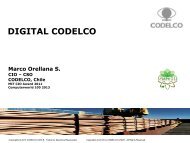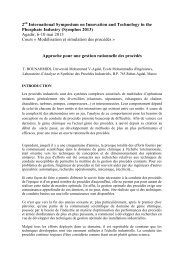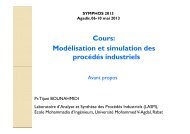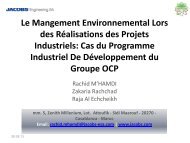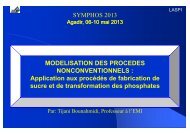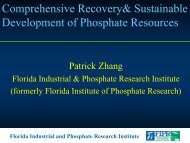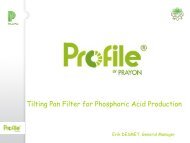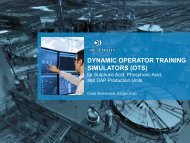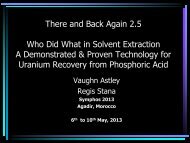Abstract SYMPHOS 2011
Abstract SYMPHOS 2011
Abstract SYMPHOS 2011
You also want an ePaper? Increase the reach of your titles
YUMPU automatically turns print PDFs into web optimized ePapers that Google loves.
DUST SUPPRESSION OF PHOSPHATE ROCK:<br />
STORAGE, CONVEYANCE AND SHIPPING<br />
EN-O-03<br />
Joseph Chan, Jeffrey Cooke, Ph.D., Tibor Horvath, M.Sc. and Sarah Aziz,<br />
B.Sc., IPAC Chemicals, Vancouver, BC<br />
During the processing of phosphate ores one is continually faced with the potential of dust generation. Without<br />
proper treatment and precautions, dust generation can cause health (air quality) issues, pollution/contamination<br />
issues, loss of product, and fire and explosion hazards.<br />
A series of dust control additives were evaluated for their efficacy on phosphate ores using the following criteria:<br />
76<br />
1) Conveyance and transloading/shipping simulation: Dust generated using a free-fall/impact conveyance<br />
transfer simulator was quantified, before and after treatment with test dust control additives.<br />
2) Storage simulation: The effect of wind on ore storage piles was modeled using a wind tunnel test apparatus.<br />
Candidate dust suppressants were evaluated according to their ability to prevent loss of product from a pile<br />
under various wind conditions.<br />
3) Wetting ability: Dust suppressants must provide rapid, thorough wetting and penetration of the substrate.<br />
Rates of wetting for candidate products were determined.<br />
4) Persistence: To optimize economic considerations, dust control performance should be maintained as long<br />
as possible. Dust control additives were evaluated for their retention of efficacy.<br />
This paper will discuss not only the results of the above testing, but also provide insight on how to use these<br />
laboratory results to provide efficient, effective dust control in real-world applications.<br />
JORF LASFAR SEA WATER MAIN PUMPING STATION EXPERIMENTAL STUDY<br />
Robert LABORDE<br />
Director CERG<br />
Rue Lavoisier - 38800 Pont de Claix / FRANCE<br />
EN-O-04<br />
This paper deals with pumping station experimental modeling and especially on the OCP Jorf Lasfar main sea water<br />
pumping station example. The station takes sea water from the Atlantic ocean by the mean of an inlet channel<br />
located at the water sea level and delivers a high flow of filtered water to the industrial users located on a shelf<br />
about 60 meters above. At the beginning of this study, the total capacity of this station was about 156 000 m3/h<br />
by the mean of twelve pumps and four downstream ducts (2 500 mm diameter and near 2 km long). The pumping<br />
station is built in such a way that it is possible to set up 6 more pumps with two additive downstream pipes.<br />
Since the industrial users needs in water capacity are increasing the pumping station has to be modified. In<br />
reference with CERG experience in this hydraulics investigation field, OCP has asked CERG for a study that would<br />
define how to increase the pumping station capacity by increasing the available pumps and running pipes numbers<br />
as well as modifying the pumps, filters and various devices characteristics. For this study, both calculations and<br />
experimental ways have been used.<br />
The study concerns the total course followed by the water from the intake channel at the ocean until the



